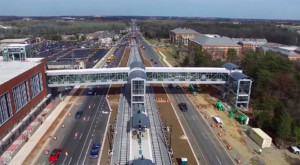 As Charlotte’s explosive growth continues, our traditional growth pattern – low-density and heavily auto-centric — is not sustainable for the generations who will live and work here in the years ahead and has made living here difficult for many today.
As Charlotte’s explosive growth continues, our traditional growth pattern – low-density and heavily auto-centric — is not sustainable for the generations who will live and work here in the years ahead and has made living here difficult for many today.
Facing similar challenges, other fast-growing cities such as Austin, Seattle, and Denver are making ambitious investments to build diverse mobility networks. Unfortunately, Charlotte’s response has been lackluster. Our bus system is ranked among the poorest in the nation, rail transit expansion has been sporadic, and safe bicycle and pedestrian networks are rare.
Expeditious development of the Transformational Mobility Network (TMN) – with interconnected mobility options to serve everyone – is essential to a strong and sustainable future for the Charlotte area.
A report from the local nonprofit group Sustain Charlotte has detailed what we can do as a city to utilize our full potential. They note that some positive steps from the TMN include:
- Non-transit projects (bicycle, pedestrian, greenways, and roadways) would receive funding as soon as the sales tax is imposed in 2023 (assuming referendum passage in 2022);
- Implementing the bus priority corridors and Envision My Ride bus improvements also in 2023;
- Cost estimates and timelines for each transit project.
But they say that other aspects of the proposal are concerning, including:
- Longer timelines for the rail projects – doubling the projected schedule for some – will significantly increase overall costs and limit our ability to achieve many goals of the 2040 Comprehensive Plan, as the future rail corridors fill up with incompatible development in the interim.
- The “one project at a time” approach to transit will delay vital improvements that our region needs now, not 20 years from now, and make it harder to meet the city’s adopted climate goals.
- No details have been shared on how the TMN sales tax’s 10 percent share for non-transit projects would be spent. The majority must go to pedestrian and bicycle infrastructure and greenways, not road capacity expansion – and still, that 10 percent may not be enough to deliver, in a timely way, the infrastructure we need to achieve adopted goals.
They believe that the best next steps include:
- Prioritizing the creation of a fast, frequent, and reliable bus network.
- Faster rail project completion, perhaps in smaller phased segments (a priority schedule already is needed for more significant segments requiring FTA funding.)
- Doing a detailed analysis to determine how much money could be saved by building the rail projects faster. Inflation and interest will increase costs the longer we wait. The new projected cost for all transit projects of $11.6 billion is equivalent to $7.3 billion in today’s dollars ($4.3B in inflation costs over 18 years).
- Augmenting the proposed sales tax with other revenue sources, potentially including value capture from the increased property values of adjacent properties and additional vehicle licensing fees. (Denver’s multi-source approach was recommended by Charlotte’s Transit Funding Working Group in 2013. Seattle’s broader approach to funding also deserves review.)
- The development of a detailed list of bicycle, pedestrian, and greenway projects, including the timing for each (following the model of the transit projects).
Building the full Transformational Mobility Network, on an expedited schedule, is essential to securing Charlotte’s position as a top-tier city.


